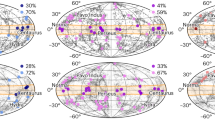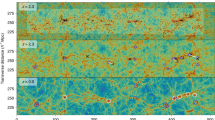Abstract
The discovery1 of a population of young galaxies at a redshift when the Universe was about a tenth of its current age has shed new light on the question of when and how galaxies formed. Within the context of popular models2, this is the population of primeval galaxies that built themselves up to the size of present-day galaxies through the process of repeated mergers called hierarchical clustering. But the recent detection3 of a large concentration of these primeval galaxies appears to be incompatible with hierarchical clustering models, which generally predict that clusters of this size are fully formed later in time. Here we use a combination of theoretical techniques — semi-analytic modelling and n-body simulations — to show that such large concentrations should be quite common in a universe dominated by cold dark matter, and that they are the progenitors of the rich galaxy clusters seen today. We predict the clustering properties of primeval galaxies which should, when compared with data that will be collected in the near future, test our current understanding of galaxy formation within the framework of a universe dominated by cold dark matter.
This is a preview of subscription content, access via your institution
Access options
Subscribe to this journal
Receive 51 print issues and online access
$199.00 per year
only $3.90 per issue
Buy this article
- Purchase on Springer Link
- Instant access to full article PDF
Prices may be subject to local taxes which are calculated during checkout



Similar content being viewed by others
References
Steidel, C. C., Giavalisco, M., Pettini, M., Dickinson, M. & Adelberger, K. Spectroscopic confirmation of a population of normal galaxies at redshifts z > 3. Astrophys. J. 462, L17–L22 (1996).
Baugh, C. M., Cole, S., Frenk, C. S. & Lacey, C. G. The epoch of galaxy formation. Astrophys. J.(in the press).
Steidel, C. C. et al. Alarge structure of galaxies at z ∼ 3 and its cosmological implications. Astrophys. J. 492, 428–438 (1998).
Steidel, C. C., Pettini, M. & Hamilton, D. Lyman imaging of high-redshift galaxies. III. New observations of four QSO fields. Astron. J. 110, 2519–2536 (1995).
Davis, M., Efstathiou, G., Frenk, C. S. & White, S. D. M. The evolution of large-scale structure in a universe dominated by cold dark matter. Astrophys. J. 292, 371–394 (1985).
Scott, D., Silk, J. & White, M. From microwave anisotropies to cosmology. Science 268, 829–835 (1995).
Pascarelle, S. M., Windhorst, R. A., Keel, W. C. & Odewahn, S. C. Sub-galactic clumps at a redshift of 2.39 and implications for galaxy formation. Nature 383, 45–50 (1996).
Lowenthal, J. D. et al. Keck spectroscopy for redshift z ∼ 3 galaxies in the Hubble Deep Field. Astrophys. J. 481, 673–688 (1997).
Kauffmann, G., White, S. D. M. & Guiderdoni, B. The formation and evolution of galaxies within merging dark matter haloes. Mon. Not. R. Astron. Soc. 264, 201–218 (1993).
Cole, S., Aragon-Salamanca, A., Frenk, C. S., Navarro, J. F. & Zepf, S. E. Arecipe for galaxy formation. Mon. Not. R. Astron. Soc. 271, 781–806 (1994).
Baugh, C. M., Cole, S. & Frenk, C. S. Evolution of the Hubble sequence in hierarchical models for galaxy formation. Mon. Not. R. Astron. Soc. 283, 1361–1378 (1996).
Kauffmann, G. The age of elliptical galaxies and bulges in a merger mode. Mon. Not. R. Astron. Soc. 281, 487–492 (1996).
White, S. D. M. & Frenk, C. S. Galaxy formation through hierarchical clustering. Astrophys. J. 379, 52–79 (1991).
Madau, P. et al. High-redshift galaxies in the Hubble Deep Field: colour selection and star formation history to z ∼ 4. Mon. Not. R. Astron. Soc. 283, 1388–1404 (1996).
Kauffmann, G., Nusser, A. & Steinmetz, M. Galaxy formation and large-scale bias. Mon. Not. R. Astron. Soc. 268, 795–811 (1997).
Madau, P. Radiative transfer in a clumpy universe: The colors of high-redshift galaxies. Astrophys. J. 441, 18–27 (1995).
White, S. D. M., Navarro, J. F., Evrard, A. E. & Frenk, C. S. The baryon content of galaxy clusters — a challenge to cosmological orthodoxy. Nature 366, 429–433 (1993).
Ellingson, E., Yee, H. K. C., Greeen, R. F. & Kinman, T. D. Clusters of galaxies associated with quasars. I — 3C 206. Astron. J. 97, 1539–1549 (1989).
Mo, H. J. & Fukugita, M. Constraints on the cosmic structure formation models from early formation of giant galaxies. Astrophys. J. 467, L9–L13 (1996).
Bagla, J. S. Evolution of galaxy clustering. Mon. Not. R. Astron. Soc.(in the press).
Lefevre, O. et al. The Canada–France redshift survey: VIII. Evolution of the clustering of galaxies from z ≈ 1. Astrophys. J. 461, 534–545 (1996).
Eke, V. R., Cole, S. & Frenk, C. S. Cluster evolution as a diagnostic for omega. Mon. Not. R. Astron. Soc. 282, 263–280 (1996).
Acknowledgements
We thank S. White for discussions. The simulations were performed at ARSC and NCSA supercomputing centers. This work was supported by the EU Network for Galaxy Formation and Evolution, the NASA/ESS programme, and PPARC. C.S.F. acknowledges a PPARC Senior Research Fellowship and S.C. a PPARC Advanced Fellowship; C.G.L. was supported by the Danish National Research Foundation through its establishment of the Theoretical Astrophysics Center.
Author information
Authors and Affiliations
Corresponding author
Rights and permissions
About this article
Cite this article
Governato, F., Baugh, C., Frenk, C. et al. The seeds of rich galaxy clusters in the Universe. Nature 392, 359–361 (1998). https://doi.org/10.1038/32837
Received:
Accepted:
Issue Date:
DOI: https://doi.org/10.1038/32837
This article is cited by
-
The realm of the galaxy protoclusters
The Astronomy and Astrophysics Review (2016)
Comments
By submitting a comment you agree to abide by our Terms and Community Guidelines. If you find something abusive or that does not comply with our terms or guidelines please flag it as inappropriate.



